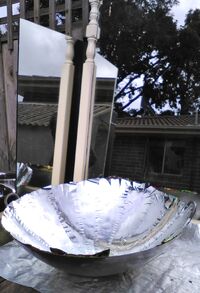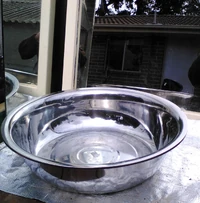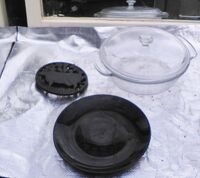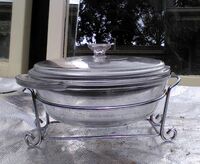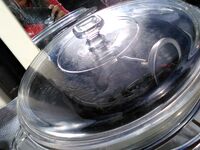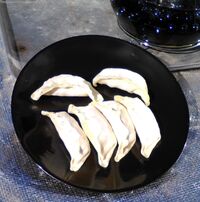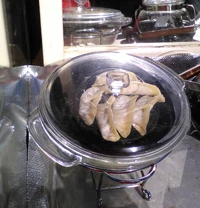|
Last edited: 9 May 2016
|
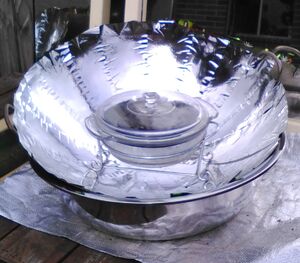
A steamer set up for dim sims, gyoza, dumplings
Here is a found object solar cooking challenge. Many cooks and chefs are used to working with woks. It is a challenge to create a portable outdoor kitchen for solar cooking, where you can quickly cook quantities of food in a safe and professional manner. So your ideas on this theme would be appreciated.... Please add a comment or send a message if you feel inspired to take up the challenge...
A wok is a 2 x parabola, with handles. Woks can be found in homes shops and markets around the world. It can be transformed by lining with mylar foil, which can be sourced from foil wrapping, chip packets, cigarette packet foil lining, aluminium cans, takeaway containers. A large wok can be supported on another bowl or wok stand, and easily rotated, adjusted on the stand. The largest 48 inch wok 121 cm diameter gives a working area of just over 1 metre square.
Equipment[]
- Large wok with a mylar surface glued in:
- Large flat base bowl:
- Mirrors or additional reflector sheet:
- Trivet or pot stand
- Black plates and bowls:
- Pyrex borosilicate glass casserole dish and wire stand:
Assembly[]
- Place the mirrors at a 90% angle on a work surface. Secure so that they don't blow over or fall forward onto the cooking area.
- Place aluminium coated surface such as this insulation roll or an aluminium tray as the base.
- Put the bowl in front of the mirrors, careful to make sure it doesn't touch the mirror glass.
- Place the wok on the bowl, also careful to make sure it doesn't touch the mirror glass.
- Adjust for latitude orientation, and time of day.
- Set the pot stand, pyrex casserole dish into the middle of the base of the wok.
- The focal point of the wok is half its height. Woks are 2 x parabolas, that is the width is twice the height for the curve.
- Therefore it is necessary to have the black surface that will hold heat, below the focal point, about a third of the height of the wok.
- The casserole dish has a black ceramic plate inside, which will heat up from refracted concentrated sunlight above, and from reflected sunlight from below.
- The black ceramic plate in this case has a cast iron trivet on it, inside the casserole dish, which will heat up to a higher temperature than the plate once the lid is on.
- The trivet is useful for creating steam when adding cold or frozen items, pour a little hot water on the trivet, and the steamer is in action immediately.
- The trivet, in this case also holds small items closer to the underside of the pyrex lid. This is where most of the heat is trapped as hot steam.
- Place a cooking thermometer in the casserole dish where you can see it, before adding food.
- Your cooking surface should be over 100 C degrees before you put any food on it, so it is sterilised.
- When you put food in place the thermometer where you can see it without opening the lid.
- Every time you take the lid off to check the contents its going to take an extra few minutes to cook.
- During cooking, check the thermometer to ensure that your food is going to reach a safe temperature. Baked goods or large pieces of food need the cooking thermometer to go to the middle of the food, to ensure it reaches the correct safely cooked temperature in the middle.
Use an oven glove when removing the lid, the sunlight is concentrated in the whole area of the mirrors and wok, so it is necessary to wear long sleeves and a glove to minimise skin sun damage.
Gyoza dumplings
Prepackaged frozen food can be defrosted, steamed or cooked in this wok and casserole dish up.
This is like having a little microwave oven in the garden.
The wok should rotate easily and adjust vertically, with the casserole dish being heavy enough to stabilise the whole structure at a table or bench working height.

